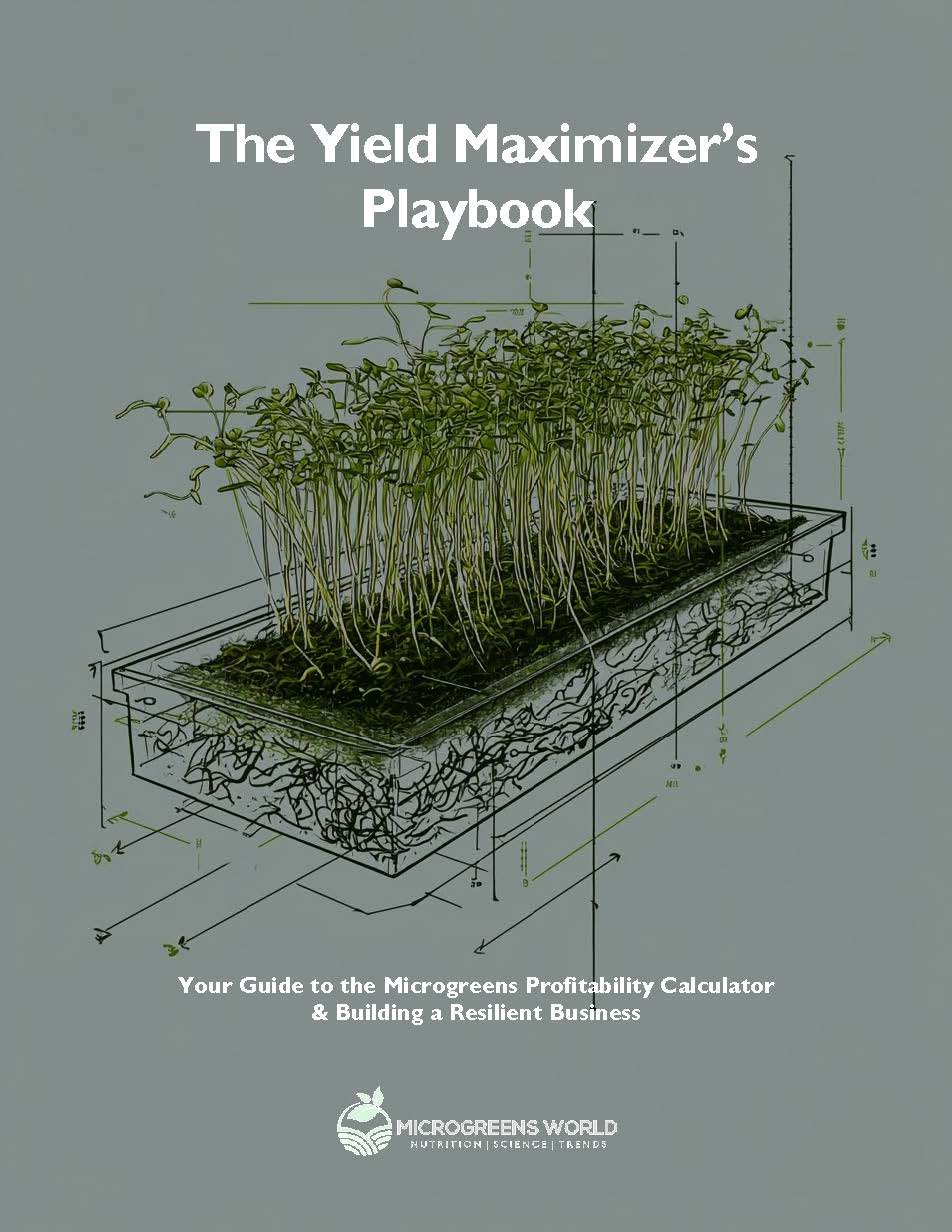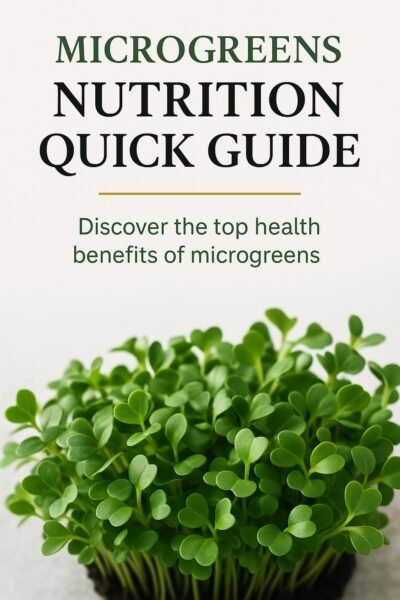Growing Microgreens Using Aeroponics
Growing Microgreens Using Aeroponics
Key Takeaways: Aeroponics
- Aeroponics is a cutting-edge method that uses misting systems to cultivate nutrient-rich microgreens suspended in the air, providing optimal nutrients for fast growth and health.
- Efficiency is a crucial advantage of Aeroponics, as it requires less water and space, delivers nutrients directly to roots, and reduces the risk of pests and diseases.
- Aeroponics allows for year-round microgreen cultivation regardless of weather or location, offering a continuous supply of fresh produce, especially beneficial in urban areas.
- With precise control over growing conditions, Aeroponics ensures consistent and predictable yields by adjusting moisture, nutrients, and light for optimal growth.
Microgreens World Knowledgebase
- Advanced Research
- Business
- General
- Growing
- Health
- Nutrition
- Science
- Trends
Did you know that microgreens can have up to 40 times the nutrients as their fully grown counterpart? It’s true! And now, thanks to a cutting-edge technique called Aeroponics, you can easily cultivate these nutrient powerhouses.
Aeroponics is an innovative method that utilizes misting systems instead of traditional soil-based cultivation. This technique offers a host of benefits that traditional methods simply can’t match.
So, how does growing microgreens using aeroponics work? Instead of planting microgreens in soil, aeroponic systems suspend the plants in air and mist them with a nutrient-rich solution. This mist gives the plants the necessary nutrients to grow and thrive. The roots are exposed to the air, allowing them to absorb oxygen more efficiently. This system leads to faster growth and healthier plants.
One of the central advantages of Aeroponics is its efficiency. Aeroponic systems use less water and space without soil than traditional cultivation methods. The misting systems deliver water and nutrients directly to the roots, minimizing waste and ensuring optimal absorption. This method saves resources and reduces the risks of pests and diseases related to soil-based farming.
Another benefit of Aeroponics is the ability to grow microgreens year-round, regardless of the weather or location. Since aeroponic systems can be set up indoors, you can continuously supply fresh microgreens regardless of the season. It is particularly advantageous for urban areas or regions with limited access to agricultural land.
In addition to its efficiency and year-round growing capabilities, Aeroponics offers precise control over growing conditions. It is easy to adjust mist systems to provide the optimum amount of moisture, nutrients, and light to maximize growth. This level of control makes Aeroponics a reliable way to grow microalgae, which enables guaranteed production yields.
By harnessing the power of Aeroponics, you can revolutionize your microgreen cultivation. With its efficiency, year-round growing capabilities, and precise control over growing conditions, Aeroponics offers a superior method for producing nutrient-rich microgreens.
So why not try it and experience the benefits of this innovative technique for yourself? In this post, learn the ins and outs, pros and cons of growing microgreens using Aeroponics.
Growing microgreens using Aeroponics is an innovative farming technique that allows plants to thrive without soil. Instead, the roots are suspended in air and misted with a nutrient-rich solution. This method provides several benefits, including faster growth and higher yields.
The cultivation of aeroponic microgreens offers precise control of the growing conditions, such as temperature, humidity, and nutrient content. This precise control means you can create the perfect environment for your microgreens to flourish. One popular way to aeroponically grow microgreens is with aeroponic tower gardens. These vertical columns have multiple levels with trays or racks for growing the microgreens. This design maximizes space utilization, making it ideal for urban farming or small-scale operations.
Aeroponic garden towers have several advantages over traditional farming methods. They require less water and nutrients because the misting system delivers them directly to the roots, reducing waste. The vertical design also allows for efficient use of space, enabling you to grow many microgreens in a small area.
Practical Application in Microgreens Cultivation
There are a few key factors to consider when setting up an aeroponic system for microgreen cultivation.
First, lighting is crucial for providing the necessary energy for photosynthesis. LED grow lights are commonly used in this type of cultivation because they provide the specific spectrum of light that microgreens need for optimal growth.
Get Microgreens LED Grow Lights at Amazon
[amazon_auto_links id=”213839″]
Another important factor is the nutrient solution. The roots of the microgreens are wrapped in air and misted with a nitrogen-rich solution as part of Aeroponics. This solution allows for efficient nutrient absorption and promotes healthy growth. For microgreens to obtain the correct balance of nutrients, their solution must be regularly monitored and adapted.
Get Microgreens Aeroponic Nutrient Solutions at Amazon
[amazon_auto_links id=”215594″]
Airflow is also a critical component of aeroponic systems. Proper airflow helps prevent mold and pathogen growth, ensuring the microgreens’ health. Fans and air pumps can maintain a steady fresh air flow throughout the growing area.
Once the microgreens have reached the desired growth stage, they can be harvested by cutting the stems just above the soil surface. This method allows for accessible collection and ensures that the microgreens retain freshness and flavor.
Benefits of Aeroponics
Aeroponics offers several benefits that significantly improve the cultivation of microgreens. One significant advantage is using an aeroponic tower garden, which allows vertical farming. This innovative system maximizes space utilization and increases crop yield.
Instead of soil, Aeroponics relies on a nutrient-rich solution to nourish the plants. The solution promotes faster growth because the roots are directly exposed to oxygen and nutrients.
Additionally, aeroponic gardens require less water than traditional soil-based cultivation, making them more sustainable and environmentally friendly.
The risk of pests and diseases is also reduced by the controlled environment at Aeroponics, which will produce better microgreens of higher quality.
With its efficient use of space, water, and nutrients, Aeroponics is a game-changer for microgreens cultivation.
Microgreens Nutrition Facts
Understanding the nutrition facts of microgreens is crucial for maximizing their benefits. Microgreens are young vegetables harvested early, typically after developing their first true leaves. Despite their small size, microgreens contain vitamins, minerals, and antioxidants. They can produce 5 to 40 times the amount of nutrients as their older counterparts.
To further enhance the nutritional value of microgreens, many growers are turning to aeroponic towers. These towers, also known as vertical aeroponic or aeroponic garden towers, use a soilless growing method that delivers oxygen and nutrients directly to the roots of the plants. This system promotes rapid growth and efficient nutrient absorption, resulting in microgreens that aren’t only delicious but also highly nutritious.
Whether you’re growing microgreens for personal consumption or commercial purposes, harnessing the power of aeroponic grow towers can help you produce microgreens that are bursting with flavor and health benefits. So, by understanding the nutrition facts and utilizing innovative growing methods, you can enjoy the full potential of these nutrient-packed greens.
Aeroponic System Setup
Setting up an aeroponic system for growing microgreens requires a few essential steps to ensure success.
First, assemble the aeroponic system tower, which consists of multiple trays for holding the microgreens. These towers are designed to make the most of vertical space and efficiently use water and nutrients.
Next, prepare the aeroponic nutrient solution, a specialized mixture of water and essential nutrients for the plants. This solution is then pumped through the tower, delivering a fine mist to the roots of the microgreens.
It’s crucial to monitor and adjust the system for factors like temperature, humidity, and lighting to create the ideal environment for microgreen growth. Monitoring will help ensure consistent and high-quality microgreens using Aeroponics.
Essential Growing Monitors and Testing Equipment on Amazon
[amazon_auto_links id=”215597″]
Harvesting Microgreens
Harvesting microgreens is a satisfying and rewarding process that allows you to savor these nutrient-rich greens’ fresh and flavorful taste.
You can harvest microgreens at their peak flavor and nutritional value when growing them using Aeroponics. One effective method is to use an aeroponic tower, which delivers a fine mist of nutrient-rich solution directly to the plant roots. This vertical aeroponic system maximizes space and promotes efficient cultivation.
Unlike hydroponics, Aeroponics requires fewer nutrients because the mist provides direct access to the roots. To harvest your microgreens, use clean scissors to cut them just above the soil line.
Harvesting these lively greens will give you a sense of accomplishment and satisfaction, whether to grow microgreens for your use or as part of an aeroponics scheme.
Pros and Cons
Aeroponics, a key strategy used in Dew Aeroponics, offers advantages and disadvantages in vegetable cultivation.
Maximizing space utilization is one of the most essential benefits of Aeroponics. You can grow many vegetables vertically with aeroponic towers, making it an ideal solution for urban gardening or limited spaces. The vertical tower aeroponic garden allows plants to grow upwards, optimizing the use of available area. Additionally, the outdoor aeroponic tower system provides flexibility in location, allowing you to grow vegetables in various outdoor environments.
Another advantage of Aeroponics is its efficient use of water and nutrients. In aeroponic systems, plants are misted with a nutrient-rich solution, ensuring they receive the necessary nutrients for growth. This method uses significantly less water compared to traditional soil-based cultivation methods. The aeroponic nutrient solution is also precisely regulated, providing plants with the necessary nutrients, resulting in faster growth and higher yields.
However, there are also some drawbacks to consider. One of the main disadvantages of Aeroponics is its reliance on technology and electricity. The aeroponic system requires pumps, timers, and misters to function correctly, which can increase the initial setup cost and ongoing maintenance expenses. Power outages or equipment malfunctions can disrupt the growth cycle of plants and impact overall productivity.
Another consideration is the difference between Aeroponics and hydroponics. While both systems rely on nutrient-rich solutions, Aeroponics uses a misting method to deliver nutrients to the plant roots, whereas hydroponics submerges the roots in the nutrient solution. This distinction can affect the ease of maintenance and the potential for root drying in aeroponic systems.
Future Research Directions
Advancements in Aeroponics, especially with hydroponics, have opened up new possibilities for efficient and sustainable vegetable cultivation. One notable innovation in Aeroponics is the aeroponic tower system, which allows vertical farming in a mist environment rich in nutrients. These tower systems maximize space usage and increase crop yields, making them ideal for commercial aeroponic setups.
Compared to hydroponics, Aeroponics delivers nutrients directly to the plant roots through a misting system. The system promotes faster growth and healthier plants. This distinction between hydroponic and aeroponic systems is crucial in understanding the benefits of growing microgreens using Aeroponics. Microgreens, which are young and tender vegetable greens, thrive in aeroponic environments due to the abundance of nutrients and oxygenation the misting system provides.
Using Aeroponics for cultivating microgreens ensures a constant supply of fresh and nutritious greens, reduces water consumption, and eliminates the need for soil. This sustainable farming method minimizes the use of pesticides and fertilizers, resulting in cleaner and healthier produce.
Aeroponics is a promising solution for urban and vertical agriculture due to the increasing demand for locally produced agricultural products. Its efficiency, sustainability, and ability to produce high-quality vegetables make it a viable option for future vegetable cultivation.
Related Questions
What Is the Nutritional Value of Microgreens Grown Using Aeroponics?
Microgreens grown using Aeroponics are highly nutritious, containing abundant vitamins, minerals, and antioxidants due to optimal nutrient absorption in the misty environment. They offer significant health benefits, including immune support from vitamin C, vision health from vitamin A, and cell protection from antioxidants. They are also versatile and flavorful for various culinary uses.
How Does Aeroponic Cultivation Affect the Flavor and Taste of Microgreens?
Aeroponic cultivation of microgreens improves flavor and taste by providing optimal growing conditions, including efficient nutrient absorption, controlled environments, and the elimination of soil-borne diseases. This method results in cleaner, more vibrant flavors and allows for better control over the growing process to produce the best flavor profiles.
Can Aeroponic Systems Be Used to Grow a Wide Variety of Microgreen Crops?
Aeroponic systems provide an efficient and controlled method for growing various microgreen crops, offering optimal healthy and rapid growth conditions. These systems allow for versatility in cultivating different microgreens while providing precision, control, and environmental benefits compared to traditional soil-based farming methods.
What Are the Specific Challenges and Considerations When Growing Microgreens With Aeroponics?
To ensure the successful growth of microgreens with Aeroponics, regular testing, and adjustments are essential to maintain a proper nutrient balance to prevent disease and pests through monitoring and sanitation practices and ensure proper misting and humidity levels for optimal growth conditions.
Are there Any Specific Regulations or Guidelines for the Commercial Production of Aeroponically Grown Microgreens?
Commercial production of aeroponically grown microgreens is subject to specific regulations and guidelines to ensure quality, safety, and compliance with industry standards. Adhering to these guidelines is crucial for meeting legal requirements, building consumer trust, and producing safe, high-quality microgreens.
References
- Sadek, Nahla, et al. “Internet of Things Based Smart Automated Indoor Hydroponics and Aeroponics Greenhouse in Egypt.” Ain Shams Engineering Journal, June 2023, p. 102341, https://doi.org/10.1016/j.asej.2023.102341. Accessed 3 Sept. 2023.
- Singh, B. D. New Systems of Vegetable Production: Protected Cultivation, Hydroponics, Aeroponics, Vertical, Organic, Microgreens. Jan. 2023, pp. 31–56, https://doi.org/10.1007/978-981-19-9016-8_2.
- Singh, B. D. New Systems of Vegetable Production: Protected Cultivation, Hydroponics, Aeroponics, Vertical, Organic, Microgreens. Jan. 2023, pp. 31–56, https://doi.org/10.1007/978-981-19-9016-8_2.
- Dutta, Anurag, and Pijush Kanti Kumar. “Aeroponics: An Artificial Plant Cultivation Technique.” Authorea, 21 Feb. 2023, authorea.com/users/587269/articles/625040-aeroponics-an-artificial-plant-cultivation-technique. Accessed 22 Feb. 2024.
- Krishna, K R. “Aeroponics to Revolutionize Crop Production.” Apple Academic Press EBooks, 4 Apr. 2023, pp. 391–412, https://doi.org/10.1201/9781003328247-6. Accessed 22 Feb. 2024.
- ”An Efficient Smart Agriculture System Based on the Internet of Things Using Aeroponics Method | IEEE Conference Publication | IEEE Xplore.” Ieeexplore.ieee.org, ieee.org/document/10112884/. Accessed 22 Feb. 2024.
- Garzón, Juan, et al. Systematic Review of Technology in Aeroponics: Introducing the Technology Adoption and Integration in Sustainable Agriculture Model. Sept. 2023, https://doi.org/10.20944/preprints202309.0097.v1. Accessed 16 Jan. 2024.
- Gasmer, Morris, et al. Wall Structure Adapted for Aqueously Grown Microgreens. google.com/patent/US20240016106A1/en. Accessed 22 Feb. 2024.
- Mohammad Reza Fayezizadeh et al. “Balancing Yield and Antioxidant Capacity in Basil Microgreens: An Exploration of Nutrient Solution Concentrations in a Floating System.” Agriculture, vol. 13, no. 9, Multidisciplinary Digital Publishing Institute, Aug. 2023, pp. 1691–91, https://doi.org/10.3390/agriculture13091691.
- Mora, Ethan. Technologies for Aeroponics. google.com/patent/US20230105146A1/en. Accessed 22 Feb. 2024.
- Atwal, Preet Pritpal Singh, and Christopher Gordon Stoner. Systems, Methods, and Apparatus for Aeroponics. google.com/patent/US20210176932A1/en. Accessed 22 Feb. 2024.







